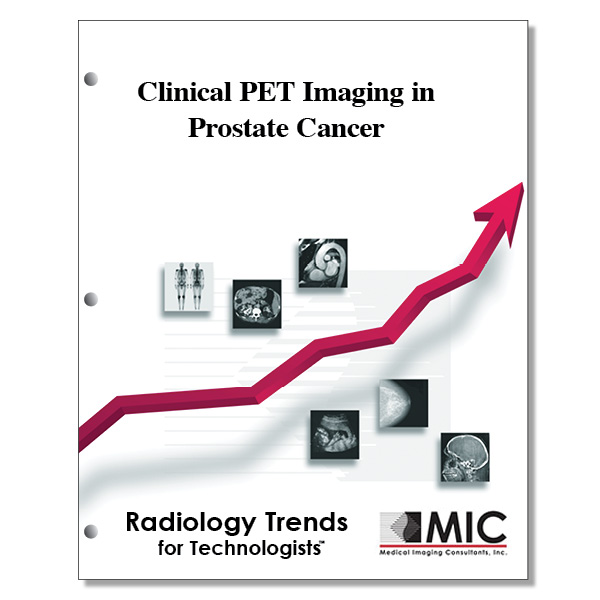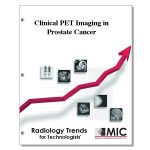

Clinical PET Imaging in Prostate Cancer
The mechanisms of actions of the clinically available PET tracers are reviewed as well as their role in the imaging of prostate cancer.
Course ID: Q00574 Category: Radiology Trends for Technologists Modalities: CT, MRI, Nuclear Medicine, PET, Radiation Therapy3.5 |
Satisfaction Guarantee |
$37.00
- Targeted CE
- Outline
- Objectives
Targeted CE per ARRT’s Discipline, Category, and Subcategory classification:
[Note: Discipline-specific Targeted CE credits may be less than the total Category A credits approved for this course.]
Nuclear Medicine Technology: 1.75
Procedures: 1.75
Radionuclides and Radiopharmaceuticals: 0.25
Endocrine and Oncology Procedures: 1.50
Registered Radiologist Assistant: 1.00
Procedures: 1.00
Abdominal Section: 1.00
Radiation Therapy: 1.00
Patient Care: 1.00
Patient and Medical Record Management: 1.00
Outline
- Introduction
- Current Conventional Imaging Strategy for Prostate Cancer
- Initial Staging
- Restaging after Biochemical Relapse
- Response Assessment
- PET Imaging Agents
- Fluorodeoxyglucose
- Localization of Primary Tumor
- Staging
- Biochemical Relapse
- Response Assessment
- Prognosis
- Summary
- 11C-Choline and 18F-Choline
- Localization of Primary Tumor
- Staging
- Biochemical Relapse
- Response Assessment and Prognosis
- Summary
- 68Ga Prostate-Specific Membrane Antigen
- Localization and Staging
- Biochemical Relapse
- Summary
- 18F-Fluciclovine
- Localization of Primary Tumor
- Staging
- Biochemical Relapse
- Summary
- 18F-Sodium Fluoride
- Staging
- Response Assessment of Osseous Metastases
- Summary
- Conclusion
Objectives
Upon completion of this course, students will:
- know the imaging modalities that are considered to be the conventional imaging techniques for prostate imaging
- be familiar with the various acronyms that are utilized both within this article and for prostate cancer management in general
- know how prostate cancer is typically diagnosed and risk stratified
- know the limitations of conventional imaging of prostate cancer assessment
- be familiar with the current uses of multiparametric MR imaging of the prostate before biopsy
- understand the reasons behind the necessity for the accurate detection of prostate cancer bone metastases
- be familiar with the AUA and NCCN guidelines for recommending bone scintigraphy for staging of prostate cancer
- be familiar with the ASTRO definitions of biochemical relapse, both after radical prostatectomy and after radical radiation therapy
- be familiar with the various PET tracer options for prostate cancer imaging and the particular role that each can serve
- recognize the limited treatment options for castration-resistant prostate cancer
- be able to identify some issues with the current response criteria for conventional imaging when evaluating prostate cancer treatment response
- be familiar with FDG and its metabolic pathway in the body
- know the suggested patient preparation, uptake times, and scan FOVs for the tracers discussed in the article
- understand the disadvantages and limited usefulness of FDG in the imaging of primary prostate cancers
- know the possible use case for FDG in prostate cancer staging
- be familiar with the results of a study of patients with biochemical relapse in whom FDG PET was performed before pelvic nodal dissection
- be familiar with some of the potential roles of FDG PET/CT in prostate cancer response assessment
- understand the reported significance of FDG PET/CT to prostate patients’ prognoses
- understand the significance of intraprostatic FDG uptake at preoperative staging
- know the advantages and disadvantages when comparing 11C-choline and 18F-choline tracer options for PET imaging of prostate cancer
- be able to identify the method used by some institutions using 18F-choline to help distinguish prostate bed or nodal recurrence from adjacent physiologic urinary activity
- understand where choline PET/CT may be useful in the localization of primary prostate tumors
- know which imaging modalities use size criteria and nodal morphologic structure for evaluating nodal metastases
- understand choline PET/CT’s potential usefulness in staging despite its moderate sensitivity for nodal staging according to the PET guidelines of the Royal College of Radiologists and Royal College of Physicians
- know choline PET/CT’s usefulness in prostate bone metastases evaluation
- know when choline PET/CT is most accurate in cases of biochemical relapse
- understand the influence that PSA has on 11C-choline assessments of biochemical relapse
- know what PSA measurement(s) should be accounted for when considering the use of choline PET/CT
- be familiar with the NCCN and EAU guideline recommendations for choline PET/CT in situations of biochemical relapse
- Understand the findings from studies using choline PET/CT in prostate cancer response assessment
- be familiar with PSMA expression
- be familiar with the newer generation of 68Ga-PSMA ligands
- be able to identify locations of physiologic biodistribution of 68Ga-PSMA
- know how physiologic urinary activity can affect 68Ga-PSMA image interpretation
- know when 68Ga-PSMA imaging is indicated according to joint procedure guidelines from the EANM and SNMMI
- know how 68Ga-PSMA PET/CT compared with CT/MR imaging in a study of 130 patients with intermediate- to high-risk prostate cancer being evaluated for nodal involvement
- recognize the advantages of 68Ga-PSMA PET/CT over 11C-Choline PET/CT when evaluating for prostate cancer biochemical relapse
- be able to identify some examples of targeted therapies for intraprostatic disease
- understand the suggestions of the joint procedure guidelines from the EANM and SNMMI about 68Ga-PSMA PET/CT imaging usefulness in biochemical relapse
- know the benefits of 18F-fluciclovine in prostate cancer imaging
- know what most investigators to date advise for patient preparation and image acquisition with 18F-fluciclovine
- be familiar with the advantages and FDA approved usage of 18F-fluciclovine
- know what 18F-sodium fluoride uptake correlates with
- know how, despite uptake in benign degenerative and inflammatory lesions, 18F-sodium fluoride PET/CT can have higher specificity than planar bone scintigraphy
- understand why 18F-sodium fluoride PET/CT is not being routinely recommended over traditional bone scintigraphy and other PET tracers
